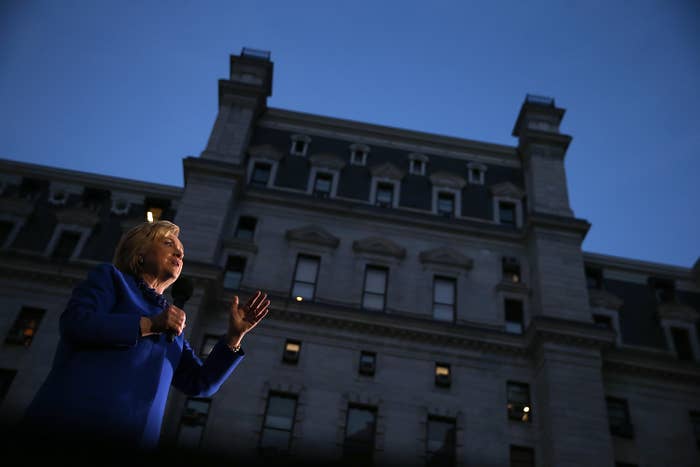
PHILADELPHIA — She mentions their names interchangeably. She describes their campaigns, their rhetoric and proposals, as equally offensive and equally dangerous. And she warns against them both in the general election.
"Here’s what I want you to understand about Trump and Cruz…”
“When I hear Donald Trump and Ted Cruz talk about international issues…”
“I will not let someone like Donald Trump or Ted Cruz say what he is saying…”
It's a subtle but significant shift for Hillary Clinton as she moves to secure the Democratic nomination and begin the work of defining the Republican opponents more broadly. In the days leading up to last week’s New York primary, where her 16-point victory came as a major setback to Bernie Sanders, Clinton began incorporating Ted Cruz into lines she’s been using against Donald Trump for weeks. On the night she won New York, she used Cruz’s name for the first time in a primary night speech. And in the days since, Clinton has hardly mentioned one candidate without the other.
“Donald Trump and Ted Cruz are pushing a vision for America that's divisive and frankly dangerous,” Clinton told the crowd in New York, citing the GOP’s approach to tax policy and abortion alongside the respective proposals by Trump and Cruz to ban Muslim immigration into the United States and to police Muslim-American neighborhoods.
Inside campaign headquarters, officials still view Trump as their likely opponent come November. The references to Cruz come less as a comment on his chances than part of a recent effort by Clinton to widen her critique of Trump, frame the field of candidates around the same “dangerous” and “divisive” platform, and position their “extreme candidacies” as a product and reflection of the larger party.
Trump and Cruz, Clinton has stressed to recent crowds, aren’t just outliers. “It’s really important that you tell all your friends,” she told a small group of volunteers last week at a phone-bank in New York, “they’ve got to pay attention to what the Republicans are saying. It’s not just Donald Trump or Ted Cruz. What they are saying is what most of the Republican elected officials believe.”
Clinton made this case in more aggressive terms late last month during a speech on the Supreme Court, arguing that these so-called “extreme candidacies” had risen from the GOP’s own “extremist tactics,” “obstruction,” and “recklessness.”
“It wasn’t long after Sen. McConnell said his number-one goal was to prevent the president’s reelection that Donald Trump started his racist campaign to discredit the president’s citizenship — remember the birther movement? — and Ted Cruz embarked on his strategy of holding the government hostage to get his way.”
“Trump didn’t come out of nowhere,” she said. “These things are connected.”
But while she extends her attacks on Trump and Cruz, casting their campaigns as symptomatic of the larger party, Clinton has also played up her history of working collaboratively with Republicans and promised to bring the country together.
The two lines of rhetoric can produce seemingly conflicting moments on the campaign trail: In the course of a stop through Rhode Island on Sunday, Clinton spoke at one turn about working with “lots of Republicans,” about the need to start “listening to each other” and find “common ground” — and at another nodded in approval as the crowd broke into boos over a line about Trump and Cruz as “snake oil” salesmen.
“I think that’s the right reaction!” she said with a laugh.
Aides have said that Clinton will increasingly embrace the role of “unifier” as the general election draws closer. On Monday, the campaign released a television ad titled “Love and Kindness,” which features backstage footage of Clinton — hugging supporters, meeting with the families of gun violence victims — as captions like “Let’s stand together” appear and a female vocalist sings, “Spread a little hope and love now.”
But beyond these early contours, campaign officials have yet to work out a day-to-day plan for engaging with the Republican candidates. Even as Clinton has dropped Sanders nearly altogether in recent days from her stump speech, the campaign remains occupied with the primary.
“The party that can get to work defining the other nominee first always has a big advantage,” said Joe Trippi, the veteran Democratic strategist. With Sanders, “the problem isn’t his attacks,” he said. “The damage he’s doing is denying her the ability to turn and define the Republicans when she could be doing that from here on out.”
Sanders has vowed to stay in the race until the California primary on June 7, but has sent mixed signals over how aggressively he intends to go after Clinton. At some rallies this week, campaigning in advance of Tuesday’s five primaries, Sanders barely mentioned Clinton. At others, he dipped back into some of his sharper lines of attack, criticizing her policy record (“Time after time after time, she has waffled”) and her $225,000 speeches to financial firms (“Not a bad day’s work”).
Clinton aides have reasoned that this Tuesday’s primaries should mark the effective expiration date on arguments that Sanders still has a path to the nomination. The April 26 states — Maryland, Pennsylvania, Delaware, Connecticut, and Rhode Island — leave Sanders with 13 remaining contests. These include California, the primary’s biggest pledged-delegate payout, but also the relatively paltry offerings of Guam, the U.S. Virgin Islands, and several less populous states in the Upper Midwest.
“After April 26, there simply is not enough real estate left for Sen. Sanders,” Joel Benenson, Clinton’s chief strategist and pollster, told reporters last month.
Still, aides have repeatedly stressed that they’re prepared to keep going.
“We do think that it is certainly within his right to go all the way,” Jennifer Palmieri, the communications director, told reporters the night of Clinton’s New York victory. “We hope that at the end of the contests, she will lead the popular vote, she will lead pledged delegates, and at that point, they will have to explain to you how they believe they can win the nomination going into the convention.”
But how would she do both until then, one reporter asked? How would the campaign contend with Sanders and at the same time prepare for the Republicans in November?
“We already are,” Palmieri answered.

